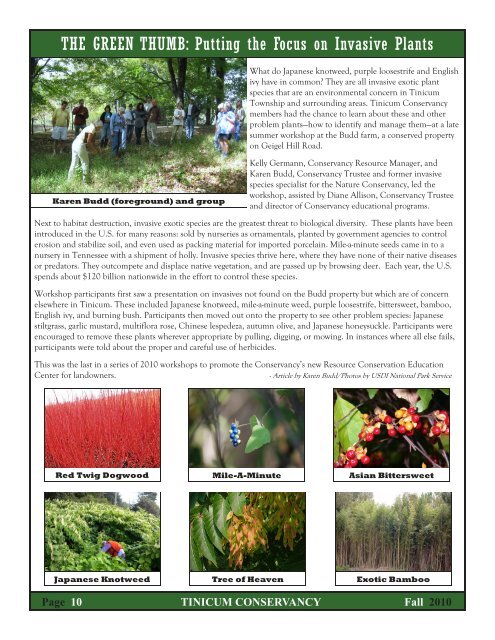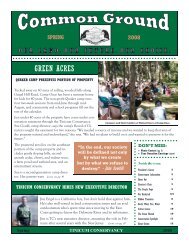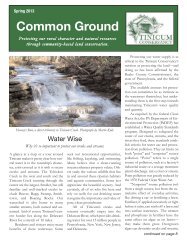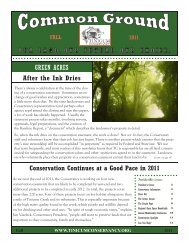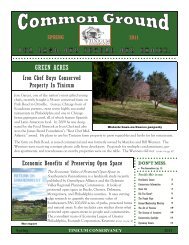Newsletter-FALL '10 FINAL FINAL - Tinicum Conservancy
Newsletter-FALL '10 FINAL FINAL - Tinicum Conservancy
Newsletter-FALL '10 FINAL FINAL - Tinicum Conservancy
Create successful ePaper yourself
Turn your PDF publications into a flip-book with our unique Google optimized e-Paper software.
THE GREEN THUMB: Putting the Focus on Invasive Plants<br />
Karen Budd (foreground) and group<br />
What do Japanese knotweed, purple loosestrife and English<br />
ivy have in common? They are all invasive exotic plant<br />
species that are an environmental concern in <strong>Tinicum</strong><br />
Township and surrounding areas. <strong>Tinicum</strong> <strong>Conservancy</strong><br />
members had the chance to learn about these and other<br />
problem plants—how to identify and manage them—at a late<br />
summer workshop at the Budd farm, a conserved property<br />
on Geigel Hill Road.<br />
Kelly Germann, <strong>Conservancy</strong> Resource Manager, and<br />
Karen Budd, <strong>Conservancy</strong> Trustee and former invasive<br />
species specialist for the Nature <strong>Conservancy</strong>, led the<br />
workshop, assisted by Diane Allison, <strong>Conservancy</strong> Trustee<br />
and director of <strong>Conservancy</strong> educational programs.<br />
Next to habitat destruction, invasive exotic species are the greatest threat to biological diversity. These plants have been<br />
introduced in the U.S. for many reasons: sold by nurseries as ornamentals, planted by government agencies to control<br />
erosion and stabilize soil, and even used as packing material for imported porcelain. Mile-a-minute seeds came in to a<br />
nursery in Tennessee with a shipment of holly. Invasive species thrive here, where they have none of their native diseases<br />
or predators. They outcompete and displace native vegetation, and are passed up by browsing deer. Each year, the U.S.<br />
spends about $120 billion nationwide in the effort to control these species.<br />
Workshop participants first saw a presentation on invasives not found on the Budd property but which are of concern<br />
elsewhere in <strong>Tinicum</strong>. These included Japanese knotweed, mile-a-minute weed, purple loosestrife, bittersweet, bamboo,<br />
English ivy, and burning bush. Participants then moved out onto the property to see other problem species: Japanese<br />
stiltgrass, garlic mustard, multiflora rose, Chinese lespedeza, autumn olive, and Japanese honeysuckle. Participants were<br />
encouraged to remove these plants wherever appropriate by pulling, digging, or mowing. In instances where all else fails,<br />
participants were told about the proper and careful use of herbicides.<br />
This was the last in a series of 2010 workshops to promote the <strong>Conservancy</strong>’s new Resource Conservation Education<br />
Center for landowners. - Article by Karen Budd/Photos by USDI National Park Service<br />
Red Twig Dogwood Mile-A-Minute Asian Bittersweet<br />
Japanese Knotweed Tree of Heaven<br />
Exotic Bamboo<br />
Page 10 TI�ICUM CO�SERVA�CY Fall 2010


